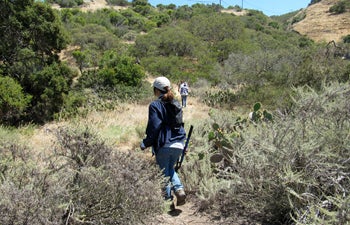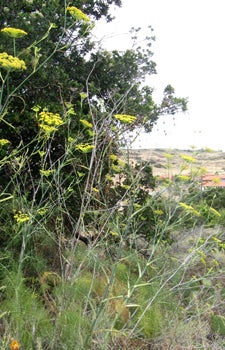A Trail-Blazing Summer Internship
Two students and two recent graduates of USC Dornsife’s Environmental Studies Program have started a trail-blazing summer interning with the Catalina Island Conservancy, where they are spending eight weeks assisting with conservation and education programs. The project, managed by Lisa Collins of environmental studies, is a collaboration between the conservancy, the Environmental Studies Program and the USC Wrigley Institute for Environmental Studies, housed in USC Dornsife.
The interns are working with the conservancy to remove fennel, an invasive plant, and have begun building a hiking trail adjacent to the USC Wrigley Marine Science Center on Catalina Island. Two graduate students from the USC School of Cinematic Arts have joined the project to develop animations that will explain the conservation effort to non-scientific audiences.
Alexandria Cheung and Sabrina Lawrence-Gomez graduated from USC Dornsife in May with their bachelor’s degrees in environmental studies. Miller Zou and Daniel Kasang will continue their studies in the program this fall as a junior and senior, respectively.
The interns began their work on June 12 when they boarded the USC vessel Miss Christi to Catalina Island. They spent their first week at the conservancy field lab facility Middle Ranch learning about Catalina Island ecology, plant identification, and techniques for surveying and collecting native plants.
With training from the conservancy staff, the students are tackling a problem with fennel that has more than century-long history on Catalina Island. They are working with Charlie de la Rosa to remove the plant, which is pervasive on the island. De la Rosa, who supervises the conservancy’s invasive species removal projects, said that once the plant takes root, it takes over. Fennel physically crowds out other plants above and below ground. It grows taller than much of Catalina Island’s native vegetation so it prevents other plants from getting sunshine; and its root system is so dense that nothing else can grow in the same soil.
Fennel, native to southern Europe and the Mediterranean region, has the scent of black licorice and has been used in cooking for centuries. It is believed to have been introduced to California in the late 1800s, and it has thrived in parts of the state, including Catalina Island and some of the other Channel Islands.
Fennel Invasion from Lisa Chung.
The interns are spending much of their summer on Catalina Island removing fennel, plant by plant, as part of a project to construct a hiking trail. They are digging up the carrot-like taproot of individual plants to extract fennel along the first stretch of the new trail. The next step will be “passive restoration” of native vegetation.
“There are a lot of seeds of native plants in the soil,” De la Rosa said. “With the removal of the fennel, the seeds of those native plants will germinate.”
The uprooting of the fennel this year will be followed by annual monitoring by conservancy scientists to deal with fennel seeds that are left in the soil.
“If we can remove new fennel plants before they flower, eventually we will exhaust the fennel ‘seed bank,’ ” De la Rosa said.
Kasang said the project is helping him understand how simple conservation can sometimes be.
“If you take out the problem, what’s naturally occurring comes back. I always hear about remediation and how costly it is, where here most of the remediation is simply removing the problem,” he said.
For the trail construction, the interns will work on a section of hillside known locally as “Deer Valley” that is just outside the boundaries of the USC Wrigley Marine Science Center at Big Fisherman’s Cove on the road to Two Harbors. The trail will follow the hillside’s natural contours to points of interest overlooking the cove and will improve an existing trail created over the years by people and wildlife climbing the hillside. Its winding path will cover about 1,000 yards when completed. This summer, the cohort will establish the first 60 yards of the trail, clearing vegetation along the rest of the pathway in preparation for future work crews.

Alexandria Cheung walks through sage and cactus on the trail-building site near USC labs on Catalina Island. Photo by Lisa Collins.
When the trail is finished, USC educators will be able to take visitors up the hillside and show them a part of Catalina Island’s environment that is different from the rest of USC’s Catalina campus.
“We were trying to find an area that has different vegetation compared with other habitats near the lab,” Collins said. “This is the only north-facing trail near the Wrigley Marine Science Center, so it has endemic plants that aren’t anywhere else on the Catalina campus. And we picked an area that has enough fennel that the students will be able to see a difference — a ‘before’ and ‘after’ that’s a result of their work.”
The participants from USC Dornsife and the conservancy are working with another organization — the American Conservation Experience — that has expertise in trail building and has worked with the conservancy for years to provide volunteers for conservation projects on Catalina Island.
Chris Baker, executive director of the American Conservation Experience, spent a week with the interns talking about “sustainable trails” that fit into the local environment and provide rewarding experiences for people hiking on them. Baker helped the interns and conservancy staff mark the entire route with flags, and a plant ecologist with the conservancy, Sarah Ratay, inspected the path to be sure it does not impact any rare species.
Lawrence-Gomez said the project has provided a good introduction to the Catalina Island Conservancy.
“It’s been nice to see how the conservancy works and how everything comes together to manage the resources,” she said.
For Zou, the internship also helps to illustrate a connection between people and the landscape.
“I’ve learned that conservation is not just about science, it’s about people and politics as well,” he said.
In late June, the environmental studies interns began working with two other USC students, both MFA candidates from the USC School of Cinematic Arts in the John C. Hench Division of Animation and Digital Arts. Collins said the two students, Lisa Chung and Michelle Yang, have a strong interest in science education and using animation to communicate science to a broader audience. Chung and Yang will spend a few days on the island and will talk to the interns from USC Dornsife to learn details about the fennel removal and trail-building projects.
“I’ve worked with animation graduate students before, and my experience with them has been fantastic,” Collins said. “They think about science in completely different ways than scientists themselves.”
Collins said this summer project on Catalina Island is built on many contributions, starting with those from the interns. In addition to the physical work of plant removal and trail building, the four interns will work on weekends on public outreach assignments with educators and naturalists from the USC Wrigley Institute and the conservancy.

Fennel, with its thick, green stalks, feathery leaves and yellow flowers, is pervasive throughout Catalina Island. USC Dornsife interns are helping to extract the plant along a hiking trail as part of the Catalina Island Conservancy’s invasive species removal project. Photo by Lisa Collins.
The idea for the internship began in Spring 2010. Collins was leading an environmental studies class on Catalina Island and spoke with Carlos de la Rosa, the head of conservation and education programs for the conservancy and Charlie’s father. The idea gained traction this spring when she returned to the island to lead another course and spoke with Charlie about an invasive species removal project. They established an internship program that would support his work and provide an experiential opportunity for students.
Working more closely with the Catalina Island Conservancy is actually part of the Environmental Studies Program’s strategic plan, said program director Jim Haw.
“Eventually we want many of our students to experience what we call ‘Catalina Throughout the Curriculum,’” Haw said. “The idea is that environmental studies students would first encounter Catalina on a field trip in their freshman year and for those who get the island under their skin this would grow into other experiences lasting a week, a month or even a full academic term.”
Catalina Island also plays a large role in other courses offered by the Environmental Studies Program, such as “Integrated Ecosystems in Micronesia.” As part of the course students learn to SCUBA dive at USC Wrigley Marine Science Center’s facilities and then take part in a scientific diving expedition in Guam and Palau. Kasang and Lawrence-Gomez participated in the course in the summer of 2010 and this year students from the course shared their experiences on Scientific American’s “Expeditions” blog.
In addition to the USC Dornsife interns’ contributions on Catalina Island this summer, Collins said the program is really a partnership. The conservancy is volunteering staff time to train the interns the USC Wrigley Institute is providing housing and meals for them, and the USC Dornsife Summer Undergraduate Research Fund (SURF) is providing financial support for Zou and Kasang, who will be continuing their work in the USC Dornsife Environmental Studies Program this fall.
Follow the progress of the internship on the Catalina Island Internship blog.